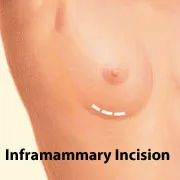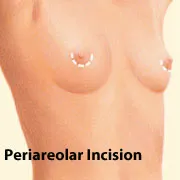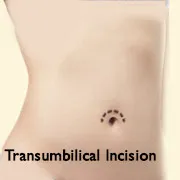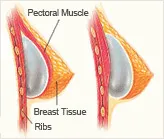Breast Augmentation in Birmingham AL
Breast Implants at Hedden & Gunn Plastic Surgery

Breast Augmentation, or breast enlargement, is the surgical placement of breast implants to enhance the size and the symmetry of your breasts. Breast augmentation can increase breast fullness and projection, and improve the balance of your figure, boosting your self-image and self-confidence.
The skilled plastic surgeons at Hedden & Gunn Plastic Surgery offer unmatched experience and expertise in helping our patients realize a fuller, more shapely and more proportionate figure with breast augmentation. Our renowned surgeons and compassionate cosmetic surgery staff can help you achieve excellent results with FDA-approved saline or silicone gel breast implants.
Dr. William Hedden, Dr. Stephen Gunn and Dr. Joshua Halka in Birmingham, Alabama listen closely to each patient to understand what you are looking for to enhance your breasts. They will also help you understand the types of breast implants and the sizes and other options that are available.
Dr. Hedden is a member of the prestigious Mentor LEAD Advisory Board, a select group of plastic surgeons chosen for their leadership and experience in breast augmentation and breast aesthetics.
Breast Augmentation Prices
Saline Breast Implants $2,500 Silicone Breast Implants $3,500
plus nominal facility fee call 205-980-1744
Breast Augmentation Candidates
You may be a candidate for breast augmentation if:
- You are physically healthy and have realistic expectations.
- Your breasts are fully developed.
- You are bothered by the feeling that your breasts are too small.
- You are dissatisfied with your breasts losing shape and volume after pregnancy, after weight loss or with aging.
- You are unhappy with the upper part of your breast appearing "empty."
- Your breasts are asymmetrical.
- One or both breasts failed to develop normally or have an elongated shape.
Rice Test
The rice test is a way to get an idea of how you might look with breast implants of various sizes prior to your consultation. With bags of rice worn inside a sports bra, the rice test allows you to quickly "try on" different sizes and become educated about fill volume measurements in cubic centimeters (cc's). Visit RiceTest.com for full rice test instructions.
Your Breast Augmentation Consultation
During your consultation with our Birmingham, Alabama plastic surgeons, be prepared to discuss:
- Why you want breast augmentation, your expectations and the desired outcome.
- Medical conditions, drug allergies and previous medical treatments.
- Use of current medications, vitamins, herbal supplements, alcohol, tobacco and drugs.
- Family history of breast cancer and results of any mammograms or previous biopsies.
Your breast augmentation surgeon will also:
- Evaluate your general health and any pre-existing health conditions or risk factors.
- Examine and measure your breasts, including detailed measurements of their size and shape, skin quality and placement of your nipples and areolas.
- Take photographs for your medical records.
- Discuss your breast enhancement options and recommend a course of treatment.
- Discuss the likely outcomes of breast augmentation and any risks or potential complications.
Breast Implants
Saline Breast Implants
Saline implants are filled with sterile salt water and contain a structure which gives the implants a natural feel. If the shell of a saline breast implant leaks, the implant will collapse and the saline naturally absorbed by the body. FDA-approved for breast augmentation in women age 18 or older, saline implants provide a uniform shape, firmness and feel.
Silicone Breast Implants
Silicone implants are filled with silicone gel that feels a bit more like natural breast tissue. Silicone breast implants will not collapse if they leak. The gel may remain within the implant shell or may escape into the breast implant pocket. Silicone implants are FDA-approved for augmentation in women age 22 or older.
Form-stable breast implants, or "gummy bear" implants, contain a thicker silicone gel and are more firm than traditional silicone implants. These breast implants maintain their shape even if the implant shell is broken.
Round, Shaped, Smooth and Textured Breast Implants
- Round breast implants have a tendency to make breasts appear fuller than some silicone implants. Higher profile options can achieve even more projection. Because round implants are the same shape all over, there is less concern about them rotating out of place.
- Shaped breast implants, also called teardrop or anatomical implants, have more projection at the bottom and are tapered towards the top. If a shaped implant rotates, correction may require a separate procedure. Placement of these gummy bear implants requires a slightly longer incision.
- Smooth breast implants are the softest feeling. They can move with the breast implant pocket, which may give more natural movement. Smooth implants may have some palpable or visible rippling under the skin.
- Textured breast implants develop scar tissue to stick to the implant, making them less likely to move around inside of the breast and become repositioned. Texturing offers some advantage in diminishing the risk of a tight scar capsule.
Breast Augmentation Risks and Safety
Each patient must decide if the benefits of breast augmentation will achieve their goals, and if the risks and potential complications are acceptable. The risks of breast augmentation include:
- Anesthesia risks.
- Bleeding.
- Changes in nipple or breast sensation.
- Fluid accumulation (seroma).
- Formation of tight scar tissue around the implant (capsular contracture).
- Hematoma.
- Implant leakage or rupture.
- Infection.
- Persistent pain.
- Poor scarring.
- Possibility of revision surgery.
- Wrinkling of the skin over the implant.
- Wrong or faulty position of the implant.
- Certain risks associated with breast implants.
Breast augmentation risks will be fully discussed prior to your consent. Understanding all potential risk factors will help with better decision-making that is best for you and your health.
It is important that you address all your questions directly with your plastic surgeon. You will be asked to sign consent forms to ensure that you fully understand the procedure and any risks and potential complications.
Preparing for Breast Augmentation Surgery
In preparing for breast augmentation surgery, you may be asked to:
- Get a blood test.
- Take certain medications or adjust your current medications.
- Stop smoking or taking recreational drugs.
- Avoid taking aspirin and certain anti-inflammatory drugs, as they can increase bleeding.
Breast augmentations are performed at our accredited Outpatient Surgery Facility in Birmingham, Alabama. Be sure to arrange for someone to drive you to and from surgery and stay with you for at least the first night.
Breast Augmentation Procedure
Breast augmentation surgery is performed using intravenous sedation or general anesthesia. Your surgeon will recommend the best choice for you.
Breast Augmentation Incisions and Implant Placement
Incisions vary based on the type of breast implant, degree of enlargement desired, your particular anatomy and patient-surgeon preference. The incisions are made in inconspicuous areas to minimize visible scarring. You and your plastic surgeon will discuss the incision options that are appropriate for your desired outcome. Incision options include:





After the incision is made, a breast implant is inserted into a pocket either under the pectoral muscle (submuscular placement) or directly behind the breast tissue, over the pectoral muscle (submammary/subglandular placement). The method for inserting and positioning breast implants depends on the type of implant, the degree of enlargement, your body type and your surgeon's recommendations.
Incisions are closed with layered sutures in the breast tissue and with sutures, skin adhesive or surgical tape to close the skin. The incision lines will fade over time.
Transaxillary Incision
Patients who want to enlarge and reshape their bustline with scarless breast augmentation often choose the transaxillary incision, or armpit incision. During transaxillary breast augmentation, the incisions are made in the armpits, leaving the breasts free of scars. A channel is then created to the breasts through which saline breast implants are inserted, placed behind the breasts and filled with a sterile saline to enhance the breast size and contour.
Transumbilical Incision
Another scarless breast augmentation technique uses the transumbilical incision. Transumbilical breast augmentation, or TUBA, uses saline breast implants inserted through a small incision at the upper rim of the belly button, leaving only a virtually undetectable scar above the navel. The implants are then tunneled beneath the skin to the tissues behind each breast and filled with sterile saline, fulfilling your desire for a fuller appearance and more shapely feminine contour.
Autologous Breast Augmentation
Breast volume can be improved with liposuction to take fat from other parts of the body and fat transfer to inject it into the breasts. Autologous breast augmentation is an option for women who are looking for a relatively small increase in breast size and would prefer natural results. Tissue expansion may be used during the weeks prior to surgery to improve results. Touch-up injections may be required to retain your improved shape.
Biplanar Breast Augmentation
Women with greater degrees of droop or volume deflation are candidates for biplanar breast augmentation, where breast implants are placed partly above and below the pectoralis muscle. This technique is a way of releasing the overlying glandular tissue from the muscle to give the appearance of getting a lift with just implants.
Breast Augmentation with Lift
If you want your breasts to look fuller and lifted due to sagging or severe drooping, a breast lift may be required in conjunction with breast augmentation. Breast lift can often be done at the same time as your breast augmentation or may require a separate operation.
For patients who only need a small lift when getting breast implants, an alternative to longer scars is the periareolar lift with small implants. There will be some puckering of the tissue, but the tissue will smooth out and appear normal in a few months. This less-invasive breast enhancement technique can still produce satisfying aesthetic results.
Breast Implant Revision or Removal
Breast implants are not lifelong devices. They can change shape or size over time. The overlying breast tissue can also change, creating a breast appearance or feel that is less desirable than the original result. It's important to have your breasts implants exchanged or removed approximately every 10 to 15 years.
Many women choose to replace or update their implants at or around the 10-year time frame. That's because many breast implants have a lifetime warranty on the actual device, but after 10 years the costs associated with surgery to replace them are no longer covered.
Breast Implant Revision
Revisional procedures are performed to change the characteristics of existing breast implants in a highly individualized procedure. Breast implant revisions are designed to improve the breast appearance by increasing or decreasing the implant size, or to change from one type of implant to another. This procedure can also be used to reposition an implant by reshaping the breast pocket, due to pain from capsular contracture, or to address concerns about implant rupture or migration.
Breast implant revision may be performed along with a breast lift or breast reduction.
Breast Implant Removal
Surgery to remove breast implants may be necessary for some breast augmentation or breast reconstruction patients. During a breast implant removal, the surgeon may also remove silicone material from implant leaks and the breast capsule, which is the scar tissue that forms after breast implant placement.
The scar tissue that forms after placement of a breast implant is often soft and does not need to be removed. However, it may also harden, causing pain and discomfort. This is often a reason to have the implants and scar tissue removed.
In some cases, the outside shell of the implant can break down, causing silicone gel to leak and the scar tissue around the implant to harden. It is important to understand that your implants should be removed for this reason.
Breast Augmentation Recovery
During your breast augmentation recovery, your breasts will be wrapped in gauze dressings, and an elastic bandage or support bra will minimize swelling and support the breasts as they heal.
Immediately after surgery, you will be taken into a recovery area for close monitoring. You may be permitted to go home when you are stable for discharge, typically after an hour or so.
You will be given specific postoperative instructions for your recovery and a follow-up appointment with your plastic surgeon. You may also receive medications or a prescription, but many surgeons prescribe postoperative medications in advance. Your prescribed medications may include pain pills and an antibiotic to prevent infection.
Wear your support garment (a bra or elastic band, called a bandeau) around the clock as instructed by your plastic surgeon. Some surgeons may ask patients to cleanse the incision sites and apply ointment, while others will ask their patients to keep tape or a bandage on. Instructions vary, so it's important to follow all your plastic surgeon's directions carefully.
Because it is possible to bleed into the pockets around the breast implants for the first several days, take it easy until you have permission to increase your activity level. Acute pain typically subsides after 1 to 5 days, but you may experience soreness and swelling for a few weeks. Resume exercise and normal activity according to your plastic surgeon's directions.
To help prevent complications and promote natural results, use these breast implant mobility exercises starting 3 to 4 weeks after breast augmentation surgery.
Breast Augmentation Results
While a breast augmentation with Dr. William Hedden, Dr. Stephen Gunn or Dr. Joshua Halka yields larger breasts right away, the final results may take a few weeks as the swelling subsides and the skin stretches. Some patients may need to wear a bandeau to help shape their breasts, especially if they have underlying asymmetry or very small breasts to start with. Incision lines may take several months, even a couple of years, to fade.
Breast Augmentation Words to Know
- Areola: Pigmented skin surrounding the nipple.
- Augmentation mammaplasty: Breast enlargement or breast enhancement by surgery.
- Breast augmentation: Also known as augmentation mammaplasty; breast enlargement or breast enhancement by surgery.
- Breast implants: Medical devices placed in your body to enhance an existing breast size or to reconstruct your breast. Breast implants fall into two categories — saline breast implants and silicone breast implants.
- Capsular contracture: A complication of breast implant surgery which occurs when scar tissue that normally forms around the implant tightens and squeezes the implant and becomes firm.
- General anesthesia: Drugs and/or gasses used during an operation to relieve pain and alter consciousness.
- Hematoma: Blood pooling deep to the skin.
- Inframammary incision: An incision made in the fold under the breast.
- Intravenous sedation: Sedatives administered by injection into a vein to help you relax.
- Local anesthesia: A drug injected directly to the site of an incision during an operation to relieve pain.
- Mammogram: An x-ray image of the breast.
- Mastectomy: The removal of breast tissue, typically to rid the body of cancer.
- MRI: Magnetic Resonance Imaging; a painless test to view tissue similar to an x-ray.
- Periareolar incision: An incision made at the edge of the areola.
- Saline implants: Breast implants filled with sterile salt water.
- Silicone implants: Breast implants filled with an elastic gel.
- Submammary or subglandular or subfascial placement: Breast implants placed directly behind the breast tissue, over the pectoral muscle.
- Submuscular or subpectoral placement: Breast implants placed under the pectoral muscle, which is located between the breast tissue and chest wall.
- Sutures: Stitches used to hold skin and tissue together.
- Transaxillary incision: An incision made in the underarm area.
- Ultrasound: A diagnostic procedure that projects high-frequency sound waves into the body and records the echoes as pictures.
Procedure Information © American Society of Plastic Surgeons

Breast Augmentation, or breast enlargement, uses saline or silicone breast implants to increase the fullness, projection and symmetry of the breasts.
Birmingham, AL Office & Surgery Suites
Hedden & Gunn Plastic Surgery140 Village Street
Birmingham, AL 35242
205-980-1744 or 800-HeddenMD
 *
*  *
* 
Contact Us Today
Questions About Breast Enhancement?
Please contact our cosmetic surgery center today to find out more about Birmingham AL Breast Augmentation at Hedden & Gunn Plastic Surgery.
To schedule your consultation at the earliest possible date, please call 205-980-1744.
